Abstract: The global Covid 19 pandemic has been affecting all aspects of the socio-economic life of all countries, including Vietnam. The most directly affected and the most significant impact is workers, their life, and jobs.
The employee affected the covid 19 epidemics, lost their jobs, and was pushed to extreme misery without help. What is the way out for them now? It fascinated and motivated me, digging in deep and learning to lead to this research.
Based on what I learned from Columbia University in New York and Georgetown University in Washington D.C during this year's summer holidays where I got scholarships. I have completed this study with the desire to provide an assessment and forecast of the long-term psychological, attitudes and beliefs of workers; on the stability of work and family life, care, and development of children; on deviant behaviors related to lifestyle, behavior, opposition, social evils, security, and order on workers under the impact of the current and later covid-19 pandemic.
Through this study, I also look forward to presenting the overall picture with businesses and employers to have policies to support workers and appropriate decisions in the coming time. The relationship between workers and employers is ensured according to its sound and human nature.
Keywords: Covid 19 impact, the life of workers, employee, jobless, compact of covid 19, social interaction, educational support, health insurance, unemployed insurance, stimulate check.
Purpose of Research
+ The objective of the study is:
- To Evaluate and forecast the long-term psychological, attitude, and belief effects of employees; on the stability of work and family life, the care and development of children; on deviant acts related to lifestyle, behavior, opposition, social evils, security, and order; on the operation, production and business situation of agencies, organizations, and enterprises.
- Provide the overall picture with the most accurate and convincing information about covid 19 on the life and jobs of Vietnam employees. This survey conducts scientifically, methodologically, systematically, ensuring comprehensiveness and typical,
Study population
The study was conducted from April 15 to May 15, 2020, dividing into two phases. Phase one is undertaken during the implementation of social isolation by the online survey method. Phase two were conducted in 9 provinces and cities, including Hanoi, Quang Ninh, Vinh Phuc; Thanh Hoa, Da Nang, Quang Nam; Ho Chi Minh City, Binh Duong, Longan; with many industry groups participating in the survey such as Tourism, Health, Education, Aviation, Agricultural, and Forestry, Textiles.
The survey participants are divided into different industry groups and types of businesses, including:
+ By sector group:
(1) Processing agriculture, forestry, and fisheries.
(2) Weaving ghost Health care, shoes.
(3) Electricity
(4) Construction.
(5) Transportation.
(6) Tourism - Services.
(7) Health care.
(8) Education.
(9) Finance
+ By type of enterprise:
(1) State-owned enterprises / Join stock (35.6%).
(2) domestic private enterprises (18.8%)
(3) FDI enterprises (15.6%); particularly,
The health care and education sectors divided into public health is 7.5%, public educational institutions are 13.8%, Non-public educational institutions account for 8.8%.
+ According to the type of labor economy: mainly in the official sector; and informal labor (Shipper, grapes, delivery, restaurant waiters.)
Furthermore, the team also went to the workers' homes and surveyed a certain number of workers in the informal sector.
The total number of companies, organizations and group cooperation participating in the survey was 124, with more than 115,000 employees. In particular, the number of direct interview samples is 3,360 employees, 347 managers, 32 business owners.
The data collection method is an in-depth interview.
Research methodology:
In this research paper, the author uses quantitative research methods in combination with qualitative research. Specifically, the following research methods:
Documentary research method: The author uses this method to analyze and synthesize documents directly related to the employee's impact during covid 19. On that basis, overview, build a theoretical framework and model for the research problem.
Quantitative analysis methodology: The author will simultaneously use quantitative (measurement and evaluation) and qualitative research; use theoretical and practical research methods, in conjunction with Probability Statistics Mathematics and Mathematical and Statistical Software (SPSS and R) to analyze the collected data. The author conducted surveys, in-depth interviews, and statistical data analysis of the Institute of Trade Union Workers data. Qualitative research results are analyzed, interpreted, drawn to scientific conclusions.
Some issues with the survey results
Due to the survey's time during and after social isolation, access to cooperation, group, organizations, and enterprises is difficult due to employers' concerns about the risk of covid 19 affected in epidemic prevention when receiving the survey team.
- A significant number of samples included in the survey by provinces, cities, and organizations, enterprises are not the ones badly affected by the Covid-19 epidemic. Even some companies are virtually unaffected. The researcher had to re-select the sample, causing the field survey to be extended
- Another problem is the time of the survey. Many employees themselves did not know or did not fully know about the policy related or benefit to them because of the interventions of the employer.
- Meeting in person with employees who must lay off their jobs, jobless / terminate their labor contracts is challenging because, at the time of the survey, they are not present at the organization or companies, nor are they present at the workers' site.
To a certain extent, the above issues directly impact survey data, the logic of the information, and the evaluation study results.
COVID 19 IMPACTING DIRECT ON JOBS AND WORKERS' LIVES
1.1 Impact on workers' jobs
According to the Department of Employment (Ministry of Labor, Invalids and Social Affairs), by June 2020, 7.8 million workers will lose their jobs, taking a layoff, and quit jobs.
According to preliminary calculations by the Department of Employment, the country has 30.8 million people aged 15 and over who are negatively affected by COVID-19, including those who have lost their jobs, quit their jobs, reduced working hours, reduced incomes. The number of employed workers also fall to the lowest in the past ten years due to the impact of covid-19.
Unemployment is rising, and the under-ingesting rate of the working-age workforce is at its highest in five years due to declining demand in the labor market.
1.1.1 Employment status
The results of direct surveys at agencies, units, and enterprises show that nearly 70% of employees are directly affected by the employment status. Specifically, 38.9% were rotated/ quit; 26.4% were suspended; 2.3% were medically quarantined. According to the General Statistics Office, as of the first half of April, nearly 5 million workers were affected, with 13% of workers losing their jobs. In particular, the processing, manufacturing, and food services industry has a very high proportion of workers who lose their jobs, accounting for nearly 20% in each sector. T Reportedly by the Ministry of MOLISA, it is estimated that in the second quarter of 2020, more than 250,000 workers in enterprises will lose their jobs. The most significant impact is in the provinces and cities with many workers such as Hanoi, Ho Chi Minh City, Binh Duong, Dong Nai. By June 2020, 478,942 employees had applied for unemployment benefits (equal to 111.7% compared to the same period in 2019). The number of people who decided to enjoy benefits was 343,376 (up 18.7% over the same period in 2019).
Chart 1.1: Employee's working status (%)
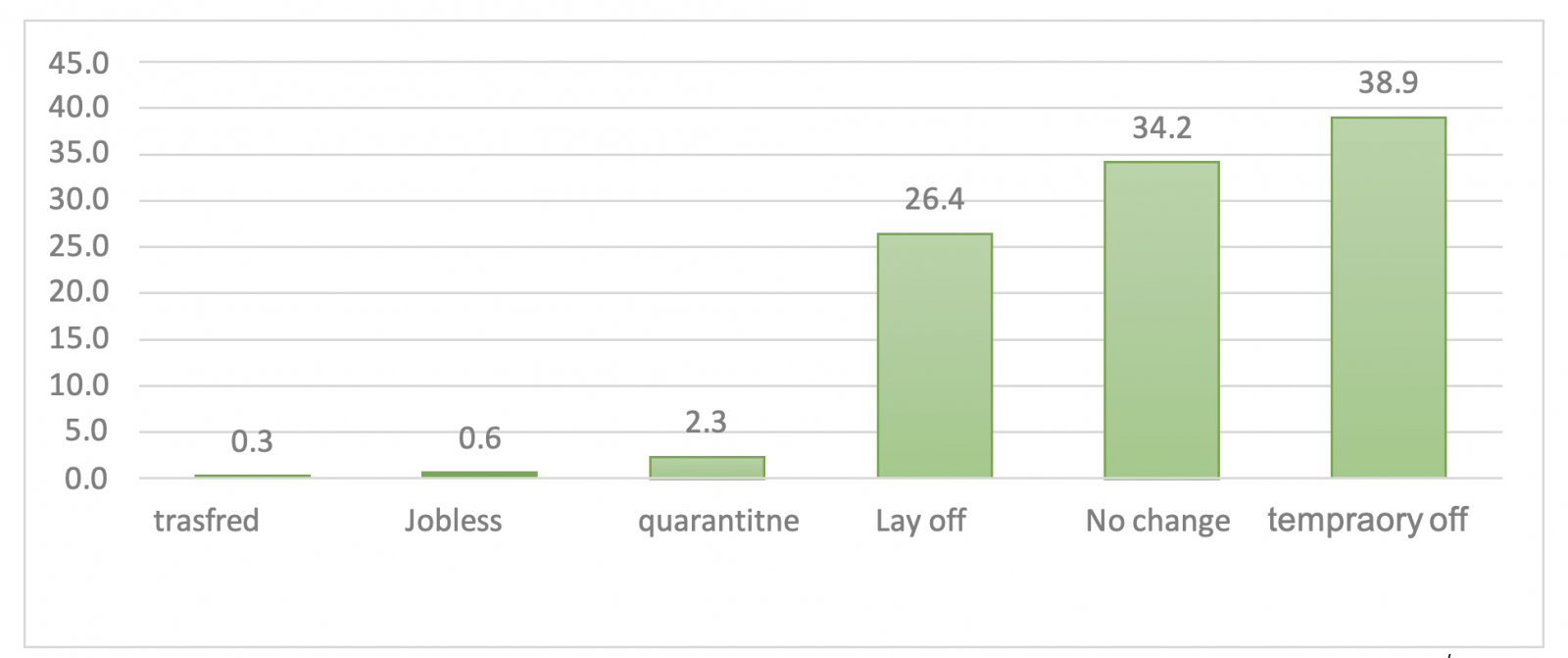
Source: Survey results of trade union worker Institute, April-May 2020
(The 0.6% figure does not reflect the rate of job losses due to the study group's inaccessibility.)
According to the industry group, the most affected workers are transport - transport, and tourism - services. The dilatation rate, stoppage/leave rotating, or transferred to another job was 88.8% and 84.2%, respectively.
The second most affected workers include Education, trade, Main, Agriculture - Forestry - Fisheries and Textiles - Footwear. The proportion of directly affected workers is between 50% and 65%. Although the epidemic situation is a high risk, health care is the lowest affected sector. Only 40.8% of workers are affected.
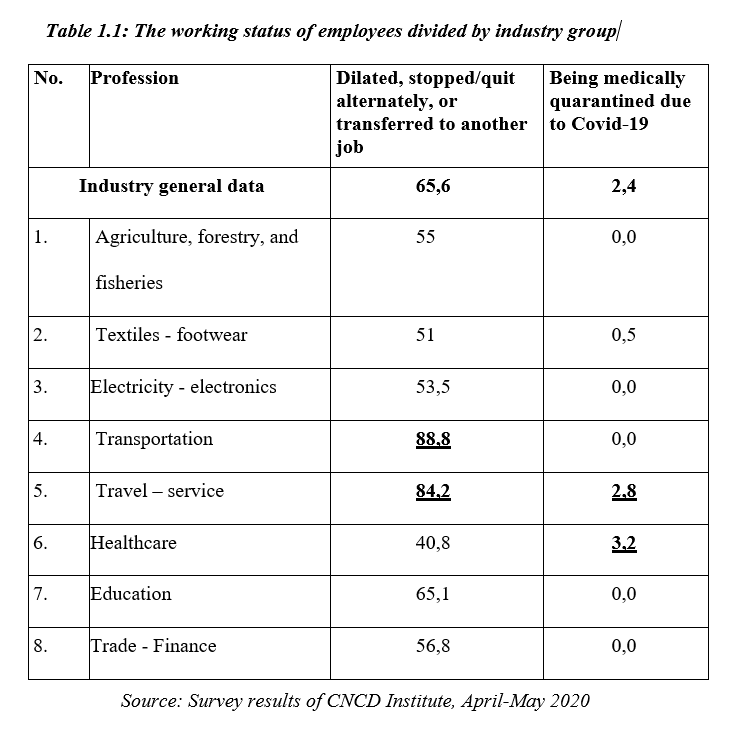
The meaning number of the situation above:
- With the transport industry: Under the travel bans and restrictions, workers of this industry are affected the earliest, most pronounced for workers who must borrow money from the bank to invest in means of transport for the transport of passengers. There was a severe problem due to work being stopped while still having to pay off loans. For the transportation industry, especially air transport, 10,000 employees had to quit their jobs. The railways, roads, and maritime sectors are in the same situation.
- In the tourism and service industry: As early as January 2020, with the information about the outbreak in China and the emergence of cases in Vietnam, the number of tourists has seriously decreased by 80%-90%. No visitors resulting in 84.2% of workers in this industry being stretched, temporarily stopped, or rotated.
- In addition, due to the specific industry, in the process of working to be exposed to various subjects, the proportion of employees affected and quarantined accounted for 2.8% (only after the health sector: 3.2%).
- According to the General Statistics Office, by mid-April 2020, nearly 740,000 workers in the service- accommodation and dining industry were affected by the COVID-19 pandemic. The proportion of workers who lost their jobs and quit their jobs accounted for about 20%.
- About 1.2 million workers in the manufacturing industry are affected. The proportion of workers who lose their jobs quit their jobs just like the service industry, accounting for about 20%
- Although the overall affected rate of the education sector is 65.1%, for non-public education, especially the price of early childhood education, nearly 100% of employees quit their jobs, reducing income from 90-100%.
According to statistics, as of March 18, 2020, about 180,000 workers are affected in the whole industry, especially in the preschool sector, where more than 30,000 workers stopped.
52.9% of employees had reduced working time. Overtime and overtime are almost entirely cut. The reason is that enterprises cannot import input materials or export goods, leading to the mandatory reduction of employees' working hours.
* In terms of working conditions: some professions and fields have a significant change in the business model, type of business, working conditions, increasing cost.
- Health care workers are affected at least by the significantly reduced number of patients visiting medical examinations and treatment. In addition, all hospitals (central) have limited reception and assessment for minor cases to prevent coronavirus express, at the same time conduct local treatment routing, provide drug singing for patients to self-medicate at home by telemedicine. In addition, the fear of going to the hospital also caused a significant decrease in the number of patients. Only medical workers in medical clinics designated as places of isolation, screening, and treatment for Covid-19 patients will be affected in the direction of increasing workload.
- With the education sector, it can say that the form and working conditions have changed radically to over 90%, from direct teaching to online teaching. Teachers must work more. If in the past, explicit instruction, composing lectures in general, combining the exchange to clarify the problem with learners during the teaching process. Now, it is more time to write speeches more thoroughly, in more detail, more specifically. Along with that, teaching psychology is complicated. It is difficult to control and monitor the quality of learning.
1.1.2. Salary and income
According to the Department of Employment (MOLISA), of the people affected (17.6 million people), 57.3% had their income reduced. Service sector workers were the most negatively affected with 72%; next is 67% Off the industrial sector; 25.1% of the agricultural, forestry and fisheries sectors. The number of workers who lost their jobs in the first six months of the year was about 1.4 million, of which workers lost their jobs due to bankrupt, dissolved, or reduced production by enterprises and production establishments.
When we look specifically at basic salaries, we notice:
a- Basic Salary
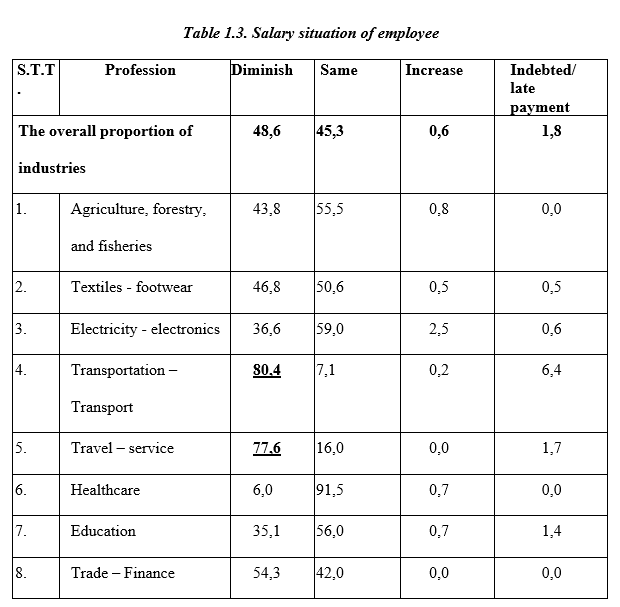
Resource: Institute of Workers and Trade Unions. Vietnam General Confederation of Labor
In terms of quantity, nearly 50% of employees suffered a reduction in basic salaries, concentrated in non-state enterprises. Specifically, 80.4% of employees in the transport industry suffered a salary reduction. The second-largest decline was the Tourism-Services sector, with 77.6% of the workforce. Trade - finance, agriculture - forestry - fisheries and textiles - footwear sectors have a rate of salary reduction of less than 50%. One sector with a significant, labor-intensive rate is Electricity and Electronics, with only 36.6% of employees suffering from a pay cut. This is the same as education.
In terms of reductions, divided into the following categories:
- For full-time workers, no job extensions: An average reduction of 20%-30% due to no overtime and no productivity bonuses.
- For the group of workers who are moved to work alternately: the average reduction of basic Salary 30%-50% because the employee does not work full working days. Total income is usually reduced by about 50%-70%.
- For the group of workers who have been temporarily suspended/ suspended labor contracts: For the group of workers in the tourism - service sector: the average reduction is up to 70-80%, only receiving the support of 1-2 million V.N.D. / month; especially for the group of Transport - Private Transport, the reduction is up to 90% -100% due to the inability to work in conditions where people minimize travel, public contact, as well as the time of social isolation. The 90%-100% reduction also occurs with informal sector workers in occupations such as "motorbikes," restaurant employees, shoe polishing ...
1.1.3. Insurance and subsidies
Due to the need to retain employees to recover from the epidemic, the problem of paying social Insurance and other remuneration regimes such as lunch/mid-shift time, meal quality for essential employees is still maintained by the units. The rate of 72.5% of employees is held in these regimes. Only 15.3 were reduced in social insurance premiums.
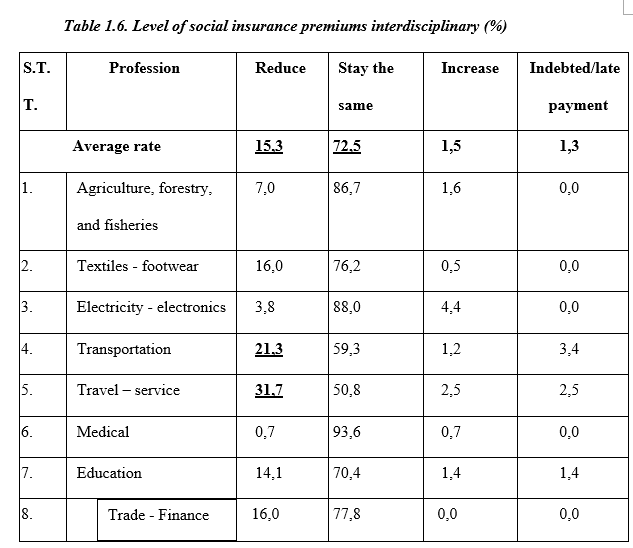
Resource: Institute of Workers and Trade Unions. Vietnam General Confederation of Labor April, May /2020
The industry with the highest rate of social insurance reduction is Services - Tourism, accounting for 31.7%. Next is the transport sector with 21.3% of employees reflecting the decline. These are also the industries with the highest debt ratio or late insurance payments, with 2.5% and 3.4%. The reason is that the high percentage of employees working alternatively makes it ineligible to pay Insurance as prescribed. This is also considered one of the significant disadvantages of these industries compared to other sectors.
* Some other support for workers during covid-19:
- Support from enterprises: (1) Ensure payment to employees reaching the regional minimum wage. (2) Working days entitled to full Salary days of extension and rotating leave are entitled to support from 30-70% according to the minimum wage/day (some enterprises do not support).
- Support from trade unions, especially CPV: Some workers receive cash support (from 500,000 - 1,000,000 VND), in-kind with essential utensils such as masks, disinfect water, rice, cooking oil, sugar, fish sauce, shrimp noodles.
- Receive support from local authorities, other socio-political organizations: necessities, food, medicine,
1.1.4. Labor mobility and support policies
Some units have made salary adjustments/salary support or changed working regimes to keep workers waiting for the epidemic to pass to restore production. Concrete:
- 27.5% of workers were transferred to other jobs. Of these, 13% of those assigned were surprised that their new job was fundamentally different from their previous one.
- 30% of employees are laid off from their jobs temporarily, quit their jobs, or end their contracts,
- 7.8% of employees who leave their jobs are supported by 01 month's Salary only 6.7% were referred for new employment advice when they quit.
- Only 58.7% of hybrids who have had their employment contracts terminated are eligible for unemployment benefits. However, according to the reflection, 12.7% were not entitled to any support when laid off.
- Spending 12.3% of CNVCLD was announced to receive a subsidy package of 62,000 billion from the Government. (However, by the time this report complete, almost all workers have received knock-in support under Resolution 42 and Decision 15 of the Government due to the provisions on eligibility)) Employees who are quitting jobs, losing their jobs must switch to selling online, carrying calves in the farmers' markets, receiving processing goods at home, helping families, babysitting by the hour, working as shippers, and even going to the sidewalk to sell vegetables. To temporary off.
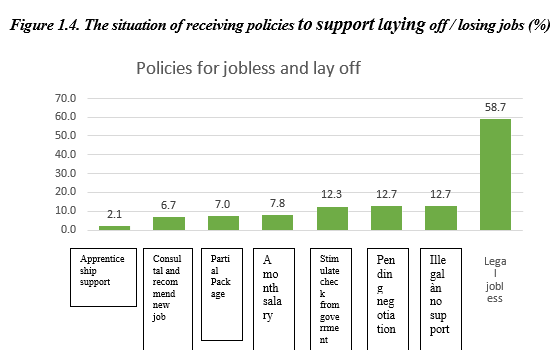
Resource: Institute of Workers and Trade Unions. Vietnam General Confederation of Labor
Assessing the suitability of the measures applied at units and business agencies, most employees feel satisfied:
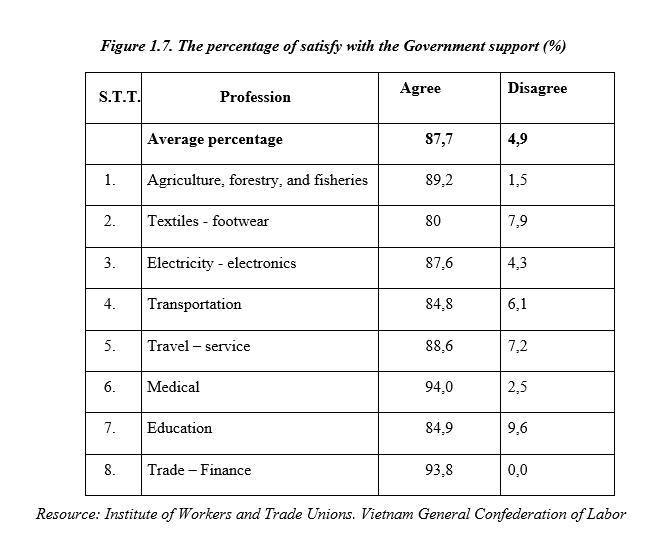
According to the industry structure, the support policies are suitable for employees, accounting for about 87.7%. The highest in the health sector with 94.0%; Trade and services were 93.8% and agriculture, forestry and fisheries were 89.2%.
1.2. Impacting the lives of workers
1.2.1. Meals and nutrition
The quantity, quality of meals, and nutrition are reduced. Difficulties at work, difficulties in reducing revenue sources, employees are forced to save and tighten spending. Instead of buying food in reputable places, with listed prices, quality is censored, now workers must choose to go to the market to buy things in toad markets, temporary markets, at a lower price. Obviously, this option will have many risks: cheap, risk of food not guaranteed quality, may not ensure freshness. But the employees have no choice, no money, spending within their means.
Biểu đồ 1.5. Meal and food's protein for workers (%)
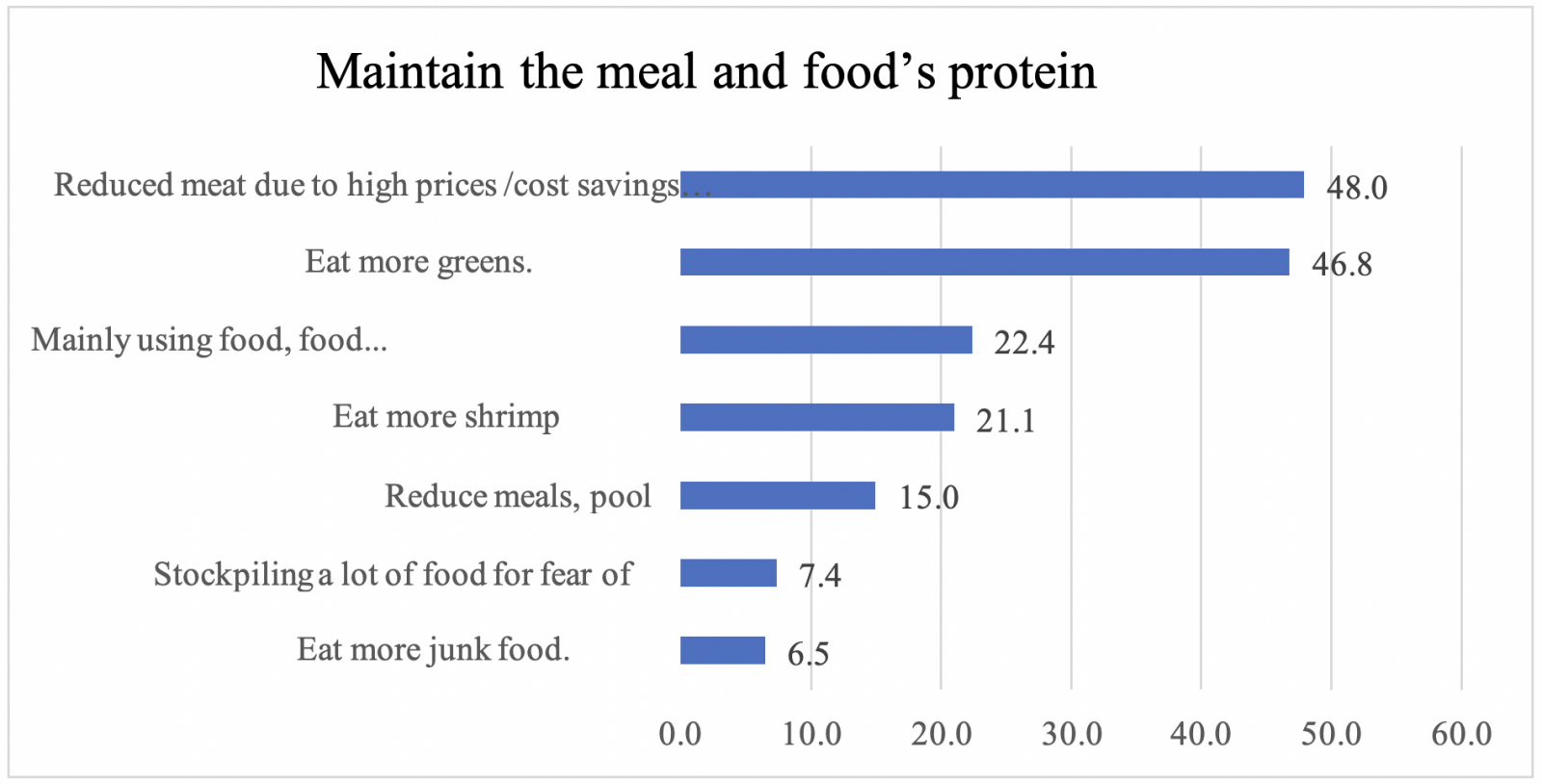
Saving money is 48% reduced daily meat intake; 46.8 must eat more greens. 22.4% had to switch from buying daily items at farmers' markets around their residences to using food supported and provided by relatives in the countryside.
Even if it's not recommended, 21.1% must eat more shrimp noodles; 15% of workers choose to eat reduced meals.
The failure to ensure and maintain nutrition, if prolonged, the health of employees and families will be significantly affected, leading to illness, illness incurs medical expenses. At that time, the situation of the worker was difficult again, piling up difficulties.
1.2.2 Spending and shopping situation
• You must use savings and loans, including "Black Credit."
Difficulties at work lead to the consequences of changes in the financial situation and spending habits of employees. Force them to save maximum spending, switch to installment purchases, even borrow to have money to live.
Figure 1.7. Worker finance statement (%)
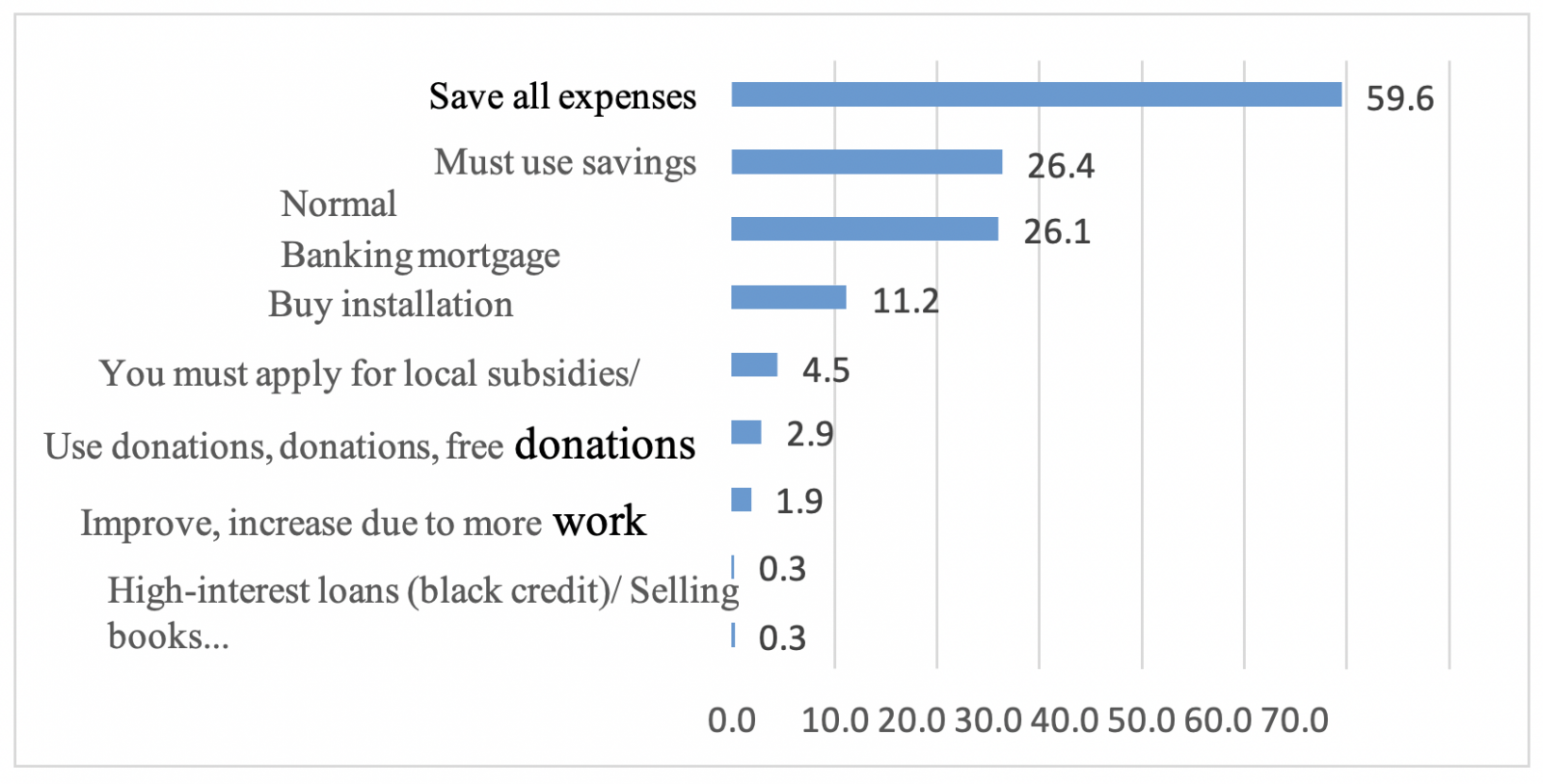
Resource: Institute of Workers and Trade Unions. Vietnam General Confederation of Labor
According to the survey results, 26.1% of employees have an average economy. The rest of the employees are greatly affected financially by Covid-19.
Falling challenging situations, 59.6% of employees choose to save their expenses; 26.4% must use savings and personal accumulation; 11.2% had to borrow money from relatives to cover living expenses; 4.5% must choose to buy installments instead of paying in full as always; 2.9% must apply for local subsidies or use donations, donations and supports to cover their lives; and 0.3% must borrow high-interest rates (black use) or sell social insurance books.
1.2.3 Healthcare
Be more conscious and proactive in health care
- Nearly 60% of workers increase training and exercise at home, avoiding public spaces to limit the spread of disease.
- 41% actively research information about covid-19 in the media.
- Regarding the implementation of measures to prevent and combat epidemics according to international guidelines: 75% wear masks when going out; 42% regularly wash their hands with soap or antiseptic solution; 37% adhere to keeping a safe distance, limiting contact with strangers, or neighbors; 31% of people are not concentrated in public places, outside the scope of offices, schools, and hospitals
1.2.4 Take care of family happiness
• Increased engagement of family members
- 77.4% of employees said that covid creates more time for family members to share, empathize and understand each other better.
- 70% said they actively did housework, sharing with the couple the care of their children.
- Even, 3.2% of the price increases in special activities, closer relationships than covid-19.
More importantly, the danger of covid-19 also makes the awareness and emotions of employees sensitive and reshaped.
• There are adverse effects in the family.
12.5% said spooned conflict increased due to economic pressures, particularly in controlling household spending.
When considering the problem in another aspect, couples staying at home a lot, every day chopping their faces, there will inevitably appear conflicts arising in the family due to having to take care of family members, not having time for themselves (accounting for 4.4%).
1.2.5 Childcare, child education, and their learning
• Have time to take care of and teach your children more.
With a break from a few weeks to a few months, this is an opportunity for parents to create better relationships with their children, make a happy and valuable time, help children feel loved, safe, and feel important to their parents. This can help children feel safe and behave better.
Family members have more time to be close to each other, making up for when they "head off the dark side to earn money," entrusting children to teachers and schools, less cohesion.
• There are many difficulties in the care and teaching of children.
Chart 1.6. The anxiety of workers in their children's education (%)
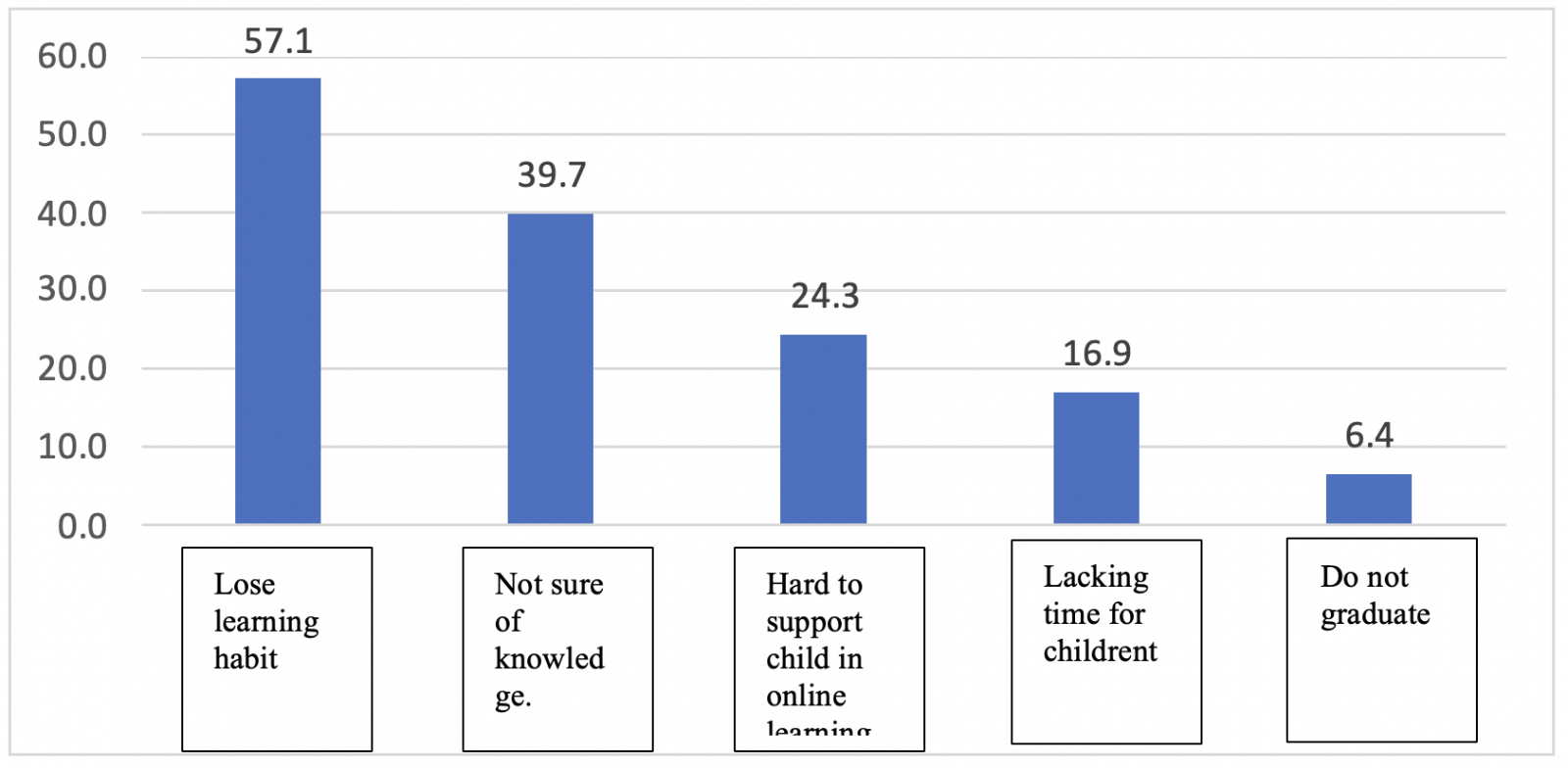
Resource: Institute of Workers and Trade Unions. Vietnam General Confederation of Labor
- Difficulty in arranging a time to care for and care for children:
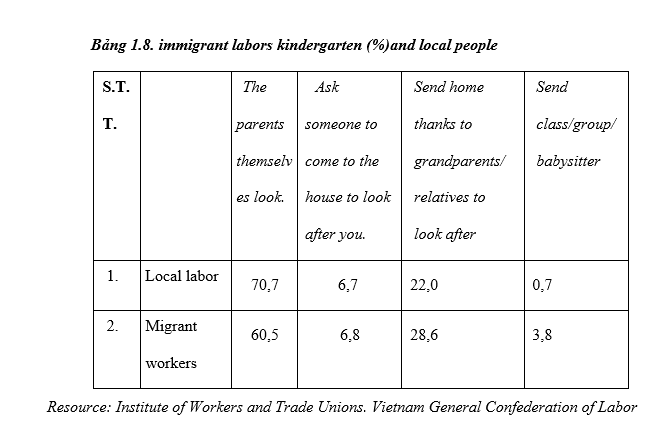
For young working families, children are mainly in kindergarten and preschool age. Many families must come up with options to adapt to the situation. 65.6% had to look after their children themselves or guide them to home school; 25.3% had to send their children home with relatives to take care of them; 6.75% had to ask relatives to look after them or hire someone to look after them (in the form of hourly or daycare). Having a family is in a complicated situation due to "anchoring" people.
- Difficulty in educating children, especially for immigrant working families. Sending your child home, avoiding the epidemic, and asking your grandparents for help is a preferred solution. However, one problem that arises is that this causes parents not to have time to be close, teach, accompany their children.
- This is also a difficulty in generating spending needs while income is being cut, especially equipping laptops is a significant expenditure arising unexpectedly of workers.
* Difficulties in tutoring children online:
- 24.3% of employees said they did not know or were challenging to accompany their children to study. When children switch to online learning since the pandemic (1) The child and his parents themselves are also surprised in the new form of learning, which takes time to get acquainted and adapt; (2) When studying online, many parents must go to work without time to observe their children's learning process, this is the concern of 16.9% of employees.
- 57.1% of employees are worried about playing and losing their learning habits; 39.7% are afraid that they will not know the knowledge when studying at home; 6.4% are concerned that their children will not be able to attend classes/ do not graduate. Many parents are forced to lower the standard of their children's learning, accept the declining academic results, only set a target for their children to go to class after the epidemic returns, accompany their children, let their children learn more to supplement the knowledge that is lacking during the epidemic.
- Worry about vision loss, developing eye defects when studying online using a computer. Many parents believe that if prolonged, without direct interaction, online learning will affect children's health, especially vision.
- Worry that your child is addicted to phones and computers, reduces social interactions, and is at risk of leading to the condition if this condition persists.
1.2.6 Social interaction and cultural enjoyment, entertainment
+ 40.5% of employees use online interaction over the internet.
+ 19% consciously limit the road to avoid fines for violating social distancing regulations.
While 15% of employees mostly relax during Covid-19, 12.4% actively work in other jobs to earn extra income.
In addition, many employees focus on relaxing activities, focusing on personal pleasures and hobbies (with a rate of 15.1%) such as watching movies, playing ornamental plants,
1.2.7 Mentally, psychologically
• Bewilderment, anxiety, gridlock, stress about the work situation
The epidemic is fast and complex. Troubled enterprises are forced to let employees dilate, stop work, or quit their jobs altogether. Although not difficult, many enterprises take advantage of the epidemic situation, still giving employees leave, cutting the rights of employees, and not settling the regime satisfactorily according to the law. When conducting production downsizing, leaving employees, enterprises have noticed that the first to be laid off are those who "due their contracts" or to review those who have suffered "violations of regulations and regulations; Quit your job for no reason..." But when announcing the quit list. Many workers are "shocked" by the layoffs.
1.2.8 Personal and family planning
Covid-19 affects and negatively impacts all aspects of social life. For everyone, the impact inevitably involves the plans and intentions of the individual and the family.
- For personal intentions: 27.4% of employees affected their study plans improved their level, improved their skills and professional skills; 13.5% were affected by the health care or treatment plan, and 13% of employees said that they were affected by sending deposits to support their parents and relatives.
- For family plans: 36% of employees are affected by their plans to save and accumulate money; 23.2% of employees are affected by their children's plans to invest in their children's education and epidemic; 21.8% of employees are affected by the payment of loans; 14.1% of affected intend to go tourism and resort; 10.3% of workers' planned home repairs could not be carried out and eventually 2.3% were affected by financial, securities or land investment plans for the future.
Figure 1.10. Workers' planning impacted by Covid 19 (%)

Resource: Institute of Workers and Trade Unions. Vietnam General Confederation of Labor
Collum from left to right:
Savings; Continuous Education; Children educational investment; Bank loan interest; Vacation; Medical care; parent financial support; reconstruction and house upgrade; stock/finance/real estate
2. RECOMMENDATIONS, PROPOSALS
Directive No. 19/CT-TTG dated April 24, 2020, of the Prime Minister on continuing to implement covid-19 prevention and control measures in the new situation, contributing to helping agencies, units, and businesses gradually return to normal operations to production and trade. However, the general opinion of enterprises, participating in the survey, to recover production and business activities before the epidemic, enterprises take a long time due to the influence not only of the domestic situation but also the impact of the international market, especially in the context of global integration as at present, the needs are dependent and interconnected very closely. At the same time, national economic protectionism also began to emerge in the U.S. market, which could see some difficulties and challenges.
It can be said that the Covid 19 epidemic and social distancing measures to prevent epidemics affect a particular organization, a specific field, and all activities of the society.
- Face the decline: in the period after the epidemic when the number of enterprises went bankrupt, waiting for the completion of the lake, bankruptcy procedures, suspension of operations in the past constantly increased, so far the number has been108,000 enterprises "Source: Ministry of Planning and Investment" and is forecasted to grow in the coming time due to the situation of the epidemic in the world is still complicated while the signs of recovery are not clear.
- Face the problem of financial reduction, as the number of enterprises in inactivity increases, the revenue from taxes decreases, and foreign investment decrease.
- While the situation of Covid-19 in the world is still very complicated, prolonged, affecting the material markets and large consumer markets of Vietnam such as North America, Europe, China. This puts pressure on supply chains to avoid faults that have severe consequences for economic development.
- Face the disadvantage of edge to the page to attract workers with other organizations and countries in the region. The covid-19 epidemic is still booming globally (by the end of June 2020, more than 10 million infections and more than 500,000 deaths) in the coming time, and businesses will have a decrease in orders, leading to more job losses and more complicated labor relations.
3.1 Proposals, recommendations
3.1.1 With the Government
Firstly, it is recommended that the Government support the employees who are suspended from performing labor contracts, are laid off, and are jobless due to the Covid 19 pandemic to receive support money, unemployment checks, and social benefits.
The Ministry of Health should prioritize the worker to get the covid 19 vaccinated, two years covid 19 pandemics from now, but the number of employees who get the vaccine is a very few until now
Government should amend standards and conditions for three groups of employees, including Employees who are suspended from performing labor contracts, leave their jobs without pay, and terminated from labor contracts; Employees without employment contracts lose their careers in the following directions:
- Adjustment, or expansion, calculates the employees' time in April, May, June 2020 but from April and no more than three months. The beneficiaries of VND 1.8 million/ person requested more workers to take more than 14 days off during the month.
- Stipulate the age of free workers to avoid non-working-age freelancers, reducing the risk of dispersing resources to workers.
- For terminated employees, the labor contract is not eligible for unemployment, it is necessary to remove the condition of "no income or income below the near-poverty standard" of Decision 15 and the implementation of Clause 4, Section II, Resolution 42, but the application period extends until the end of December 2020. Because you only get a maximum of one.
- Supplementing conditions and standards for employees to be suspended from performing labor contracts or unpaid leave, but enterprises still pay social insurance" employees after the epidemic. Many enterprises apply this situational solution through employee agreements and do not report reductions to social insurance agencies. Although keeping jobs, the life of workers in the time of the epidemic is complicated because there is no source of income.
Secondly, it is recommended that the Government direct Vietnam's social Insurance some solutions to support employees as follows:
Flexible social insurance policy to avoid employees who are not eligible for the time of implementation of the suspension of labor contracts and conditions for participation in compulsory social Insurance support (even if only support from April following Resolution 42 /NQ-CP). This is due to the provision that the employee must be participating in the compulsory social Insurance time immediately before the postponement of the implementation of the labor contract or unpaid leave. In addition, the time for suspending the performance of the labor contract, unpaid leave within the term of the labor contract must be from 01 consecutive months or more from April 1, 2020, to the end of June 30, 2020, and the time of starting to postpone the implementation of the labor contract, unpaid leave from April 1, 2020, to the end of June 1, 2020." Thus, to enjoy the support policy in April, employees must participate in compulsory social Insurance March. Meanwhile, many provinces (e.g., Vinh Phuc) were declared epidemics from February 1, 2020. Therefore, some enterprises have had to suspend operations, agree with employees to suspend labor contracts, leave without pay from February and March 2020, and have reported a reduction in social Insurance (especially tourism, travel, accommodation enterprises. How is very real for workers. Therefore, it is necessary to:
They are allowing cases where the agreement on suspension of the implementation of the labor contract, unpaid leave, rotating leave for 14 days or more of the month, still be paid compulsory health insurance according to the subjects of labor relations to ensure the continuous and uninterrupted health insurance benefits of employees.
Issuing specific guidance, agreeing to participate in health insurance during the period of suspension of labor contracts, unpaid leave for 14 days or more in the month is still entitled to pay compulsory health insurance according to the subjects of labor relations because there are currently localities, social insurances enterprises to pay health insurance for employees during the period of postponement of labor contracts. Still, some localities do not agree to let enterprises participate in health insurance for employees, which affects the legitimate rights of employees to continuous health insurance benefits without interruption.
Thirdly, it is recommended that the Government direct the Bank for Social Policy to create favorable conditions for employees to access loans with administrative procedures, resolve documents quickly so that the support package is timely.
Fourth, propose the Government several solutions related to enterprises and markets that have an indirect effect on people's jobs and lives, such as:
- Reduce land tax, electricity, and water prices for enterprises during the epidemic to recover operations. Specifically, the Government directed the Electricity of Vietnam to consider reducing electricity prices until the end of 2020 because the current policy of reducing electricity prices for production enterprises and commercial enterprises from April to June is ineffective, not necessary. After all, enterprises do not have orders in this period, so production activities are limited, and the electricity demand is not high. The discount is evaluated according to the operational characteristics of each industry.
- It is necessary to consider supporting businesses that have not / less cut labor during the recent Covid-19 pandemic. In many cases, these businesses strive to maintain operations and keep the workforce in the context of market stagnation are complex units that need support.
- Consider adjusting the subject of enterprises only needs to reduce revenue by 20% or more in the first quarter of 2020 compared to the fourth quarter of 2019 or reached to the same period last year will receive support from the Government. For payday loan enterprises, it also corrects the revenue conditions as above.
- Request the Government to direct the Ministry of Finance and the General Department of Taxation to consider not collecting personal income tax of 10% on the number of enterprises supporting workers to quit their jobs or lose their jobs due to the impact of the Covid-19 pandemic to help workers to reduce difficulties and find new jobs to stabilize their lives. (Specifically, as in the case of Pouched Company in Ho Chi Minh City)
- It is proposed to consider adjusting the conditions for enterprises to stop paying social Insurance retirement and death fund to be more suitable to the current situation when enterprises start to go into production and economic recovery. Because the company must have 50% of the employees, who have been laid off for a month or more to be eligible to postpone social insurance payments, it has not solved enterprises' difficulties.
- Request to exempt or reduce the Disaster Prevention Fund in 2020.
- There are solutions to support capital for enterprises, create open legal corridors, quick administrative procedures for businesses to access bank capital. Consider reducing bank interest rates on loans of enterprises to support enterprises to maintain and restore production
- The National Assembly, the Government, the Ministry of Labor and Social Affairs, the Social Insurance of Vietnam, and local authorities. It is necessary to join hands, actively and goodwill remove difficulties in implementing the Government's support package and minimize the negative impact of the Covid-19 epidemic on businesses, jobs, people's, and workers' lives.
COMMENT ON THE RESEARCH RESULTS
So far, this research got many helpful, used in the recommendations proposed to the Government to expand and increase support for workers affected by the Covid-19 epidemic.
We got a positive result. The Government has listened and adjusted with Resolution No. 154/NQ-CP dated October 19, 2020,
On amendments and supplements to the Government's Resolution No. 42/NQ-CP dated April 9, 2020, on measures to support people in difficulty due to the Covid-19 pandemic, and the Prime Minister's Decision No. 32/2020/QD-TTG dated October 19, 2020, on amending and supplementing some articles of decision No. 15/2020/QD-TTG dated April 24, 2020, on the implementation of policies to support people in difficulty due to the Covid-19 pandemic.
A highlight of the report in the study conducted, at the time of implementation, is the earliest, most comprehensive, most specific research of Covid-19 for workers, in both employment and life aspects. (Reports by other organizations primarily focus on the impact of Covid-19 on businesses and the labor market; or only on a specific, narrow group of audiences.) Therefore, the research data of this report attracted the attention of many agencies and organizations related to labor and employment.
The study accurately and time reflected the actual situation and trends in underrating and difficult living conditions of Vietnamese workers. Many of the research data in this report are still completely valuable in reflecting the status of employment and workers' lives under the impact of the Covid-19 pandemic.
References:
+ Institute of Workers and Trade Unions. Vietnam General Confederation of Labor http://congdoan.vn/home
+ Statistics of the Department of Labor and Employment of the Ministry of Labor, War Invalids and Social Affairs
http://www.molisa.gov.vn/
+ Vietnam Odor Insurance: https://baohiemxahoi.gov.vn/
+ The Government's Resolution No. 42/NQ-CP of April 9, 2020, on measures to support people in difficulty due to the Covid-19 pandemic
+ Decision No. 32/2020/Q.D.- TTG dated October 19, 2020, on amending and supplementing a number of articles of decision No. 15/2020/Q.D.- TTG dated April 24, 2020, of the Prime Minister on the implementation of policies to support people in difficulty due to the Covid-19 pandemic.
+ State Bank of Vietnam, Vietnam Bank for Social Policy
https://vbsp.org.vn/
LONG HIEN LE
Address: 3184 43 rd, Astoria, New York.
New York, August 27, 2021





